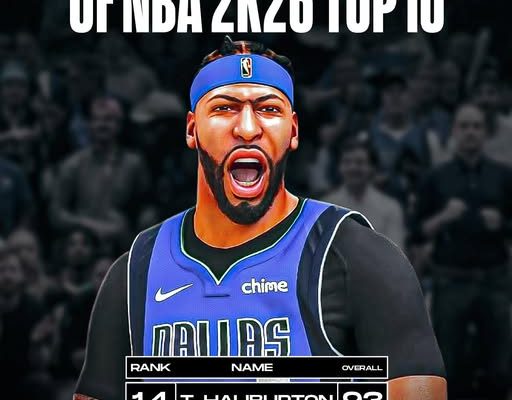The release of every new installment of NBA 2K has become a yearly ritual in the basketball world, a time when fans eagerly dissect player ratings, compare stars, and debate whether the developers captured reality or missed the mark. NBA 2K26 is no different, and one of the most talked-about names attached to the latest ratings update is Dallas Mavericks forward Anthony Davis. A dominant presence when healthy, Davis is both celebrated for his elite two-way abilities and criticized for inconsistency and injury setbacks. So when the game revealed his official rating, the question immediately arose: did 2K get it right, or was the assessment off target?
Anthony Davis is one of the most polarizing stars in the NBA. On one hand, he is undeniably among the most gifted players of his generation, a big man with guard-like skills who can defend at an elite level while also scoring from anywhere on the floor. On the other hand, his career has been defined by injuries and stretches of play where his production did not fully match the potential everyone knows he has. Now with the Mavericks, Davis represents both a cornerstone and a lightning rod of discussion, because his rating is not just a reflection of individual ability but also a statement on how well the developers believe he can deliver in today’s NBA. The rating system of NBA 2K always tries to balance past performance, current skill level, and potential impact on a team. With Davis, that balance is particularly tricky, because he has seasons where he looks like a top-five player in the league, and others where durability issues overshadow his production. In evaluating whether the game got his number right, it’s necessary to examine what Davis brings to the floor, how he has performed in recent seasons, and how that compares to both his peers and the context in which ratings are assigned.
Statistically, Anthony Davis is a force that is difficult to argue against. When on the court, he produces at an elite level: averaging well over 20 points per game, double-digit rebounds, and anchoring a defense that can look entirely different with his presence versus without it. His ability to protect the rim, switch onto guards, and still be a scoring option in the post or midrange gives him a unique versatility. NBA 2K ratings are often reflective of a player’s two-way ability, and Davis has long been considered one of the league’s few legitimate two-way superstars. However, his availability has been a constant concern. The game developers had to weigh whether his talent should override the fact that he has missed significant stretches of multiple seasons. This is always the balancing act for players with a history of injuries: should a virtual representation reflect peak ability or the likelihood of being consistently available?
When looking at comparable stars around the league, the question of fairness becomes sharper. Players like Giannis Antetokounmpo, Nikola Jokić, and Joel Embiid are consistently rated near the very top because of both their dominance and ability to lead their teams deep into playoff contention. Davis, at his best, belongs in the same conversation, but his fluctuations mean that his rating usually lags behind them. Still, if we’re comparing pure skill, is he significantly behind? Probably not. In terms of defensive prowess, Davis may actually have an edge on some of them, while offensively he is still a 25-points-per-game caliber scorer when healthy. If 2K gave him a rating in the low 90s, many would see it as justified given his production and unique skill set. If he were placed in the high 80s, critics would argue that the developers allowed durability issues to overshadow peak talent.
Beyond statistics, there’s also the “eye test.” NBA 2K ratings are not purely analytical—they often attempt to capture the reputation and perception of a player. Davis, despite criticisms, has a reputation as a game-changer. Opposing coaches prepare game plans around him, and teammates benefit from his presence in ways that do not always show up on the box score. The Mavericks, who acquired Davis with hopes of pairing him alongside Luka Dončić, clearly valued his ability to elevate their defense and provide a reliable inside-outside scoring threat. If the developers aimed to reflect the fact that he is still seen as a franchise-altering player, his rating should lean higher. If instead they wanted to punish inconsistency, a slightly lower number might make sense.
Another factor worth considering is the trend of how 2K adjusts ratings throughout the season. The initial release is only the beginning. Players can see their numbers rise or fall depending on their real-world performances. In that sense, Davis’ starting rating is less about final judgment and more about a baseline. If he starts the season strong, particularly by staying healthy and helping Dallas win, his rating can climb back toward the elite tier where his skills suggest he belongs. If injuries once again keep him sidelined or diminish his impact, the rating can decline accordingly. This dynamic system means that while fans may argue about the number today, the reality is it will likely change as the season unfolds.
Fans themselves are always split when Davis’ name comes up in rating discussions. Some argue that he remains one of the league’s most underrated stars, overshadowed by flashier scorers but providing more overall impact when measured across both ends of the floor. Others insist that it is impossible to give him a top-tier rating until he proves capable of playing consistently across an entire season. Social media reactions to his NBA 2K26 rating reflected this divide: some celebrated it as recognition of his talent, others felt it was either too generous or not generous enough. What this shows is that Davis sits at a rare intersection in the basketball world—few players inspire as much debate over their value.
The context of the Mavericks also plays a role in how people perceive his rating. With Luka Dončić as the clear face of the franchise, Davis is not being asked to carry the same weight as he once did in New Orleans or even Los Angeles. Instead, he is in a role that allows him to complement a superstar guard while anchoring the defense. This could make his contributions less obvious in box scores but more impactful in terms of team success. NBA 2K ratings, however, typically reflect individual attributes more than team role. This means Davis’ value to Dallas may be higher than his rating suggests, because what he provides in synergy with Luka cannot easily be captured by an individual number.
To truly answer whether 2K got it right, one has to consider what the purpose of ratings really is. If the goal is to simulate peak ability, then Anthony Davis deserves to be among the top-rated big men in the game. His combination of scoring, rebounding, rim protection, and versatility has few equals. If the goal is instead to represent a combination of ability and availability, then it is reasonable to dock him a point or two for his inconsistency. But even then, placing him outside the elite tier would feel unjust, because when he plays, the numbers and the impact do not lie. The problem is that Davis’ career has been defined by extremes, and ratings are an attempt to capture a consistent baseline that simply may not exist for him.
What becomes clear is that debates like this are part of the appeal of NBA 2K itself. The game is not just a simulation but also a conversation starter. Fans dissect ratings as much as they discuss playoff series, and players themselves often respond to their numbers publicly, showing that the developers’ decisions resonate in real-world locker rooms. Davis’ case is particularly interesting because it forces fans to confront the question of how to value talent versus durability. It raises the bigger debate of what a “rating” really means—whether it should serve as recognition of skill or as a predictor of reliability.
For Anthony Davis, his NBA 2K26 rating is more than just a number on a screen. It is a reflection of his complicated legacy as a star who can dominate any given night but whose career has also been defined by what-ifs. Whether fans agree with the rating or not, it shines a light on why Davis remains one of the most compelling figures in the NBA today. As the season progresses, both his real-world performance and his virtual number will continue to be scrutinized. If he thrives in Dallas, staying healthy and contributing to deep playoff runs, the rating will almost certainly rise and the debates will shift in his favor. If not, the skeptics will once again feel vindicated.



